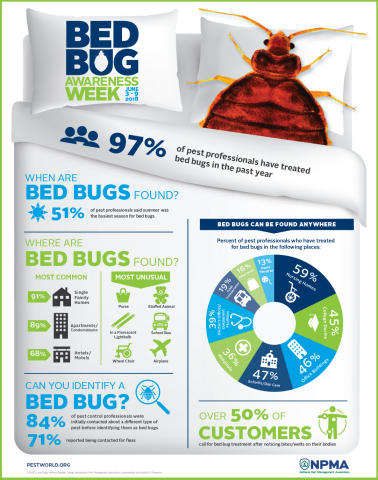by Brianna Crandall — June 8, 2018 — The National Pest Management Association (NPMA) just released the findings of its 2018 Bugs Without Borders research, which surveys pest control professionals on the prevalence of bed bugs in the United States. The survey reports that 97% of pest professionals treated for bed bugs in the past year, and more than half say summer is the busiest time of year.

The survey found that 97% of pest control professionals treated for bed bugs in the past year. Graphic courtesy NPMA
The results also reveal just how frequently bed bugs are confused with other pests. In fact, 84% of pest control professionals reported being contacted to treat another type of problem only to discover bed bugs present instead. The most common doppelganger? Fleas, as 71% of respondents reported being contacted to treat a suspected flea problem when in reality the customer had bed bugs.
Cindy Mannes, vice president of public affairs for NPMA, remarked:
We’re finding that while bed bugs remain a pervasive issue and the public is concerned, general awareness and knowledge about these pests is alarmingly low. Bed bugs continue to infest virtually anywhere humans congregate, making vigilance key to curbing bed bug infestations, especially as the summer travel season kicks into gear. Our goal is to arm the public with the information they need to be proactive in preventing a bed bug encounter, whether at home or on the road.
To help educate the public on the importance of bed bug prevention, the NPMA has declared June 3-9, 2018 as Bed Bug Awareness Week, a national observance recognized by Chase’s Calendar of Events, and is sharing the top findings from its 2018 Bugs Without Borders survey:
Almost all (97%) pest professionals have treated bed bugs in the past year. A majority of them say that overall bed bug service work (69%) and the prevalence of these pests (66%) are both increasing.
Bed bugs may be easily confused with other pests, as 84% of pest control professionals were initially contacted about a different type of pest before identifying them as bed bugs. The majority of these contacts (71%) were about fleas, followed by cockroaches (28%).
More than half of pest control professionals noted that they receive the most bed bug complaints during the summer, as increased travel during this time of the year may help spread bed bugs from vacation destinations to homes or other facilities, or even from college lodgings to homes as students go on summer break.
The top three places where pest professionals encounter bed bugs are single-family homes (91%), apartments and condominiums (89%), and hotels and motels (68%). However, bed bugs can be found in high numbers in a variety of other places:
- Nursing homes — 59%
- Schools and day care centers — 47%
- Office buildings — 46%
- College dorms — 45%
- Hospitals — 36%
- Public transportation — 19%
Bites are the most commonly reported sign of an infestation (92%), and more than half of people reach out for treatment after discovering bites and welts on their bodies. Although some people immediately develop a skin reaction to bites, others may take two to three days before showing obvious symptoms or any symptoms at all, meaning that people could be unaware of a bed bug problem until a full-blown infestation has taken root.
Typically found in couches and bed frames, bed bugs can also be found in some of the most unexpected places, including stuffed animals, wheelchairs, airplanes, school buses, purses and even inside bedside lamps, according to the report.
When traveling, NPMA advises to pack a small flashlight and thoroughly inspect the entire room before unpacking, including behind the headboard, under lights, and inside dressers, sofas and chairs. Pull back the sheets and inspect mattress seams and box springs, particularly at the corners for signs of bed bugs. Avoid placing luggage on upholstered surfaces or luggage racks with hollow legs where bed bugs may hide unseen. When arriving home from a trip, vacuum luggage thoroughly before storing it. Consider using a garment hand steamer, which can kill any bed bugs or eggs that may have traveled home. Wash and dry all clothes — even those that have not been worn — on hot cycles.
The majority of pest professionals agree that this bloodsucking pest is the number one most difficult pest to control. If an infestation is suspected, NPMA recommends contacting a licensed pest professional, as bed bugs cannot be effectively treated with do-it-yourself measures.
When working with a qualified professional, NPMA says to follow these simple steps to make bed bug eradication more efficient:
- Clean, remove clutter, organize and vacuum.
- Follow directions and guidelines given by the professional and prepare correctly.
- Report problems as early as possible, at the first sign or suspicion.
For more information on bed bugs, visit NPMA’s PestWorld.org website.




